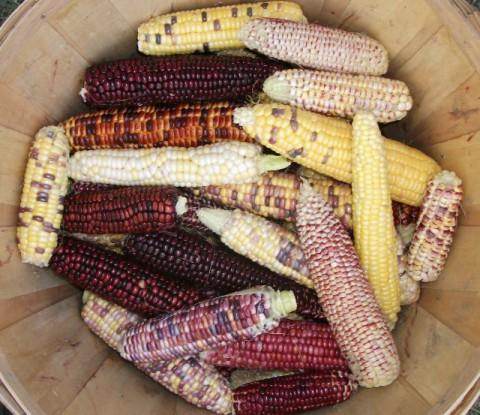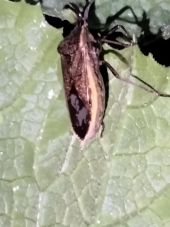I cruised through this site, and smiled, seeing familiar sources of GREAT info (Thanks Joseph, yet again) John, etc. I am beginning my permaculture journey in a "serious" (i.e., I finally bought my homestead, have a few acres, etc- not that my uber intense urban permie in a year rube goldbug maximize your gardening space erector set plant utopias weren't "serious" or anything (or to anyone who does it on small scale) and though I have been a little off in space (err, off the internet, outside, FAILING (ha) fighting insects, trying to irrigate, trying to grow things, trying to make compost, blah blah blah) despite the first growing season of mostly "fail fail fail"- I wanted to chime in, that a lot of the opinions expressed on the crosses being better (especially if they are local landrace crosses) I feel to be completely true. This is especially true for me in the high desert of New Mexico. I read every book on "growing things in the high desert"/permaculture in the desert" etc etc and I saw the caveat about "What you thought was gardening disappears when you move to the high desert", but because I was so studious, (er insane) I just thought "Well, I am going to make it work-whatever!" I definitely saw what was being written, and this was shocking to me since I was creating my own soil, amending with everything good under the sun (and spending some $$$) doing it, buying plants/seeds from top notch companies we all know and love (or most of us, but that's another thread) and still, utterly failing, due to insects, high winds, bizarre drought microclimates, equally bizarre wet (mushrooms?! on my land?! wtf (but I thought "hey cool, it's damp there-wonder what I can do there?!") -It was truly mind blowing when I wasn't retiring to my bedroom for a feeling sorry for myself nap- or in tears. (looking at my credit card/checking account for all the great stuff I bought and had such high hopes for)
I haven't seen from the thread, (and I apologize if you're regularly on the site, and I haven't seen your familiar "face" and you're doing Permie stuff all the time, or have been doing it for a long time-or you're kinda "new" like me) but all I can offer to you is this : I live in the area of New Mexico (at least in my state, though "The Three Sisters" has/is done worldwide) that is "known" for prowess, even when everything else died-period) for growing. This year was brutal. I am the intern/volunteer for Flowering Tree Permaculture (ongoing)- hopefully forever (you might have read about flowering tree in Gaia's Garden, Roxanne is an amazing woman, and so kind to me) and I was out in the fields with Roxanne, learning from her and Rose (her daughter, also on the board of directors of flowering tree) and I'll leave all the Flowering Tree info and updates to the lady in charge (via her Facebook, and website etc) as it's her wonderful 35 year creation- (and she's really busy, but regularly updates the Facebook page, etc) and the news in the fields, and other things (like building Adobe Ceremonial houses!) are hers to share- but of course, because all Permaculturists (for the most part! as we know from this great site!) are generous, after my periods of education/work/intern-I often get little gifts of seeds or other things to try at home. I also find that after spending a long day in a field, or building, it does really help to go home and try to do it again, even on "mini scale"- Anyways, not to divert from the thread-
But, All I know, is that, this year was really rough for the Southwest, and according to Roxanne, it was in comparison to other years in terms of crops, and insects. I wouldn't speak for her, but she has lived in my area of Northern New Mexico her whole life, and had FT for 35 years as her permaculture site. It's great that others here, have insights for fellow permies on their experience, since I was so, so, so so so rarin' to go on my land (even after working 8 hours in 102 degree heat with flowering tree) that I was truly, devastated, (and starting to wonder if I just "sucked" at permaculture) that things were failing-crops, insects, I couldn't get things irrigated evenly- so it was soothing to hear this info from a person who has worked the land season after season. I hate even mentioning "climate change" (because it terrifies me to the point of wanting to put my head in the sand like an ostrich-despite my own personal efforts to offset my contribution to it) but It can't be ignored.
hopefully this tome isn't making anyone's eyes glaze over, but here were my own impressions, including my own miserably failed squash. I have been planning a blog, but isn't everyone who likes permaculture and doing it, "planning a blog", or "meaning to update their already up blog" (wink smile)
A) Insects (especially grasshoppers where I am, which is kind of up on a mesa top mixed with agricultural land within 3000 feet of the rio grande) were out of control. Last year, I was told the area got record rains- I also think New Mexico is getting record rains this year. This is good and bad, but when I was lamenting my failure to grow anything (basically) Roxanne said that high rains in the high desert, can often equal lots of bugs and insects,and though water is life, despite the aquifers getting refreshed- growing things can be really horrible. It seems like the normally, tough as nails weeds (that grow, even in areas where there is no soil, or water) just go gangbusters- I have weeds that are seriously 4 ft tall, and got that way, in a matter of weeks.
the hoppers- and squash bugs, and other insects, breed and love this damp cool shade, and even if you are cutting them down, and spending $100s of dollars on Semaphore- they laugh at you.
B) Since I live in an area that has been farmed (and still is, but many of the farms are 10 acres of less, or (inspiring) the individuals who have this land, farm a small portion out of respect for their history-especially when it concerns Chile, melon, the three sisters, etc) I watch every morning with horror as I sip my coffee on my back porch (remember I am high up on a bluff looking down at the river a few thousand feet below me) my neighbors, out on their little tractors, or walking on foot- SPRAYING SPRAYING SPRAYING SPRAYING. Yes the acequia is there, and that irrigates the land, we have lots of water where I live (probably the only place in New Mexico, which is why the land is expensive, and never is for sale (I lucked out) but despite all the heartwarming traditional methods and "respect for the land/cultural history"- IT seems that stops with pesticides. Until I set up a little perch/ chair/ thrifted coffee table on this back porch, I didn't always notice the goings on of my neighbors, (other than the light whir of their small, often 50 yr old tractors milling about in the mornings) and I have to say, this was kind of disturbing to me. Luckily, the topography is on my side in terms of my own land, and I hope there isn't too much spray spread reaching where I am growing things- but I think it would be wise to look into the history of spraying near you, on your property (even if you don't do it yourself and haven't for a few years) as I think, (WAIT WE KNOW) this glyphosate poison- lasts, decimates the natural order of things, and I think that some aspect of things being so "out of whack" on my land- had to do with the rampant use of this product (in certain areas) on the property by the previous owners (yep found the good old roundup and other horrible things left in the shed when they vacated the property-sadly, I think they thought they were being "nice"-at least I was able to know for sure without a soil test)
I don't know where your garden is, but I shot photos of areas in which I was aware roundup was being used (or other pesticides) not to grow things- but mainly due to former residents wanting to have some kind of suburban "lawn" in the high desert, playing "god" what have you, I don't know. - In these areas, there were definitely MORE weeds, MORE insects. So I guess the point in this "illiad" of a bullet point is : maybe where you are growing has a history that isn't conductive to what you're trying to do. I am learning this slowly, just watching the life/death/ cycles of plants, insects- as days go by. This doesn't help you eat, or have a market garden- but just in a conservation/ecologically conscious way- It is both enlightening and sobering.
C) I completely agree with Joseph on the landraces and his thoughts. I had tons of cool heirlooms from upstate new york (where I relocated from) that I had saved seeds from my favorite organic farms there- very few, even the ones that I protected like a hawk from the insects- seemed to even "like" it around here climate wise. (That's pretty well known of course) The thing that surprised me, is this "landrace" "preference" shown of the plants- seemed to stand true- even if I had containers filled with the most expensive, fabulous, organic soil and soil amendments-and put them directly facing south, and played "god" myself with drips, etc- The jury is out to why that is, since obviously, greenhouses and the like grow all sorts of things in completely non-hospitable (in their natural state) environments- but that is how it went for me, and it was flummoxing, and my checkbook is SAD. (and I have no yummy veggies so -yeah bummed)
However, There was a light for me, in education- as I saw, that the plants that did SURVIVE, (but perhaps, had their leaves all eaten, or didn't get to bloom, etc) were ones that were local landraces- all of em. Even the ones that grew and then were eaten (due to the crazy weather and insect issues this year) showed they would thrive in even drought conditions- and those were ancient Pueblo corns, native berry bushes, and trees that had been nurtured and cultivated for 20 years to survive and thrive in our climate by Gordon Tooley of Tooley's Trees in Truchas, NM (look him up, he's great and so is his wife Margaret- if you like trees, they offer a serious internship through the Quivera Coalition (that is also listed on Attra)
http://quiviracoalition.org/New_Agrarian_Program/Tooley_s_Trees/index.
but even a couple, (and I am looking forward to meeting with Gordon and Margaret, and have him come to the house, and see what "happened" with the ones that aren't thriving-probably tell me what I did wrong, ha- and also discuss why certain varieties, (I saved up and purchased about 400.00 in trees from the Tooleys-) are doing well.
This has to do of course with our own individual microclimates, and our own individual screw ups (ha), or other factors-that I find interesting since I want to do permaculture for the rest of my life.
Accepting that insects ate everything (or whatever) and things failed, is not so hot when you are trying to live off the land, or start a cottage industry/market farm, and I know that such acceptance can be devastating if you want to earn an income to support a family, or help your dream of living off grid work, what have you. Trust me, i could not articulate in type the level of disappointment and frustration when I compared hours of interning/volunteering/visiting local farmers, 14 hour days trying to get zone 1, zone 2 into "shape", saving and budgeting for materials/tools, drips, etc- But in the end, nature is nature, and then there are our- and others (like with the roundup "festival" of spray going on around me) mistakes.
D) I post, and I smiled when I was Tyler posting on this thread, since the last time we interacted was on my CHICKEN TRIUMPH. But my "permaculture insect control"- that kicked ass (pardon my little swear, but I was BLOWN AWAY) was getting chickens. I now have 20, and I will probably have 50 by years end. Even as small pullets, they took to the grasshoppers and nymphs (and carpenter ants, and grubs) with wild abandon. I barely have to give them any store bought feed, they free range, and have free range shelters (that I built from discarded stuff I found, or dead logs, sticks) and I thought perhaps this was the universe giving me a small "bone"- for all the effort I put in- as the chickens saved many of the plants-hopefully they can rebound and grow something next year-but without them, I would have lost everything.
I cannot remember, (and I apologize if it was a permie member) I read in a forum, about someone creating a "Barrier" for the pests with chicken paddock areas around their vegetation. I tried this, in my own way (I am still figuring this paddock system out) but it worked.( "worked" is of course I didn't lose the 50.00 apple tree, though right now, it is barely out of the ICU) So- if you can somehow have your garden in an area that you could do this "Great Wall of Chicken" barrier- I suggest it.
E) Another strange thing, that I had wanted to share on here, and I guess I will here, since it applies is that I used DE- a lot, but the weird/cool thing I had wanted to share with everyone, is that, it is commonly thought usually that chickens don't like some bugs (like carpenter ants, or other ones that chew) because of their bitterness. I had one squash (that sadly didn't give me anything, but is still alive-) and I put DE all over it, and then spritzed diluted peppermint oil all over it, even directly on the bugs that were on or near the plants- Well this seemed to provide some kind of "candy coating" and the bugs that the chickens weren't interested in AT ALL, all of a sudden became delicious treats and they were fighting over the bugs, (and had no interest in the veg whatsoever) I will definitely use this little method again. I think I had a little bit of orange oil I added as well.
F) I noticed the squash bugs near me, will investigate the old cornmeal trick. (eating it and then their guts exploding or whatever) I have no idea, or the science/etymology background to say that this is true for their digestive tracts as it is, say, ants- but all I know is I have put out little capfuls (the caps on say, pasta sauce that I am reusing) of blue corn meal, in little strategic areas- There are dead squash bugs belly up nearby, and even other pests dead nearby that seem to have sampled this natural trick.
maybe try dusting your squash with it- or leaving out a little dish. It at least saved my squash from totally dying and I have something green in this sea of desert brown.
So the jist of my treatise, is I think Permaculture insect control works very well, but I think, as others have expressed, (and with much more brevity than I, ha ha!) I think it might be helpful to dig deeper into some of the ideas expressed with permaculture, and focus on landraces, squash that grows, or has grown, or has been nurtured and naturally selected by people like Joseph as ones that thrive and survive- for your area. Get some birds, if you can't deal with birds, encourage the ones that are already around you, with little capfuls of water and some wild bird seed (that helped too, and I have a wonderful bird utopia now, so many cute nests and happy animals, and yes LESS BUGS)
I also think it would be good to consider moving (if you can) where you planted your squash, due to the soil comments/roundup comments expressed- and just the differing microclimates one can have in one space of yard- shade from a tree, or a garden patch near your fence that borders a vacant lot (oh the grasshoppers and other bugs LOVE vacant overgrown lots, yes I'm dealing with that too, I think my husband and I might just...... buy the land, it is so annoying)
any who, ten brownie points to anyone who actually read all this, and I hope some of my blather helped you at all. It has been an interesting and somewhat humiliating first season, but I am undeterred because of the little triumphs.
Joseph, I had meant to contact you (in some way) because as another experiment, I am going to try to grow a "Lofthouse grid garden" with your plants, and mimicking the way you grow in Utah. I am at nearly 6000 elevation and my climate is somewhat different, but I thought it would be a) a good permaculture experiment b) you would be interested to see how it goes here c) I could learn and then start to use my own adaptations and "hacks" and continue the genetic and regional diversity of landraces in areas that aren't always hospitable to growing (like the high desert)
okay, better go check on those wonderful chickens






























 1
1

















 1
1





 9
9










 3
3




 1
1




 1
1




 4
4









 1
1




 1
1




 2
2








 3
3





 1
1









 2
2




 1
1












 6
6








 2
2








 2
2




 Sharon
Sharon
 2
2




 1
1




 1
1






 1
1





 4
4













